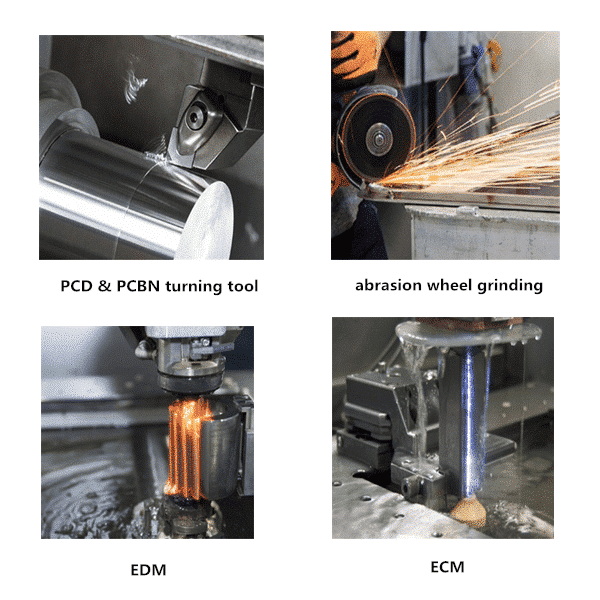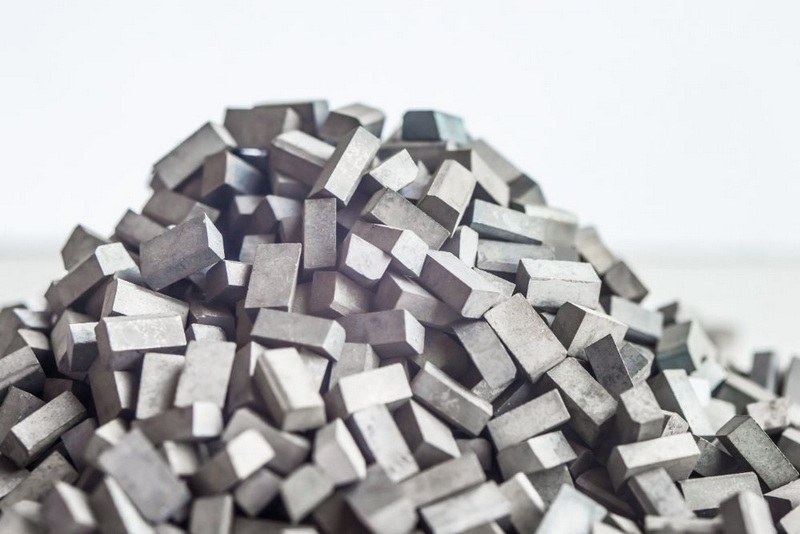Content Menu
● Introduction to Titanium and Tungsten Carbide
>> Titanium
>> Tungsten Carbide
● Comparison of Titanium and Tungsten Carbide
>> Hardness and Wear Resistance
>> Strength and Impact Resistance
>> Weight and Density
>> Corrosion Resistance
>> Cost and Production
● Applications of Titanium and Tungsten Carbide
>> Titanium Applications
>> Tungsten Carbide Applications
● Considerations for Material Selection
● Conclusion
● Frequently Asked Questions
>> 1. What is the primary advantage of titanium over tungsten carbide?
>> 2. Is tungsten carbide more expensive than titanium?
>> 3. Which material is more resistant to scratches?
>> 4. What are the typical applications of tungsten carbide?
>> 5. Can titanium and tungsten carbide be resized?
● Citations:
When comparing titanium and tungsten carbide, it's essential to understand their unique properties and applications. Both materials are renowned for their strength and durability, but they serve different purposes due to their distinct characteristics. In this article, we will delve into the properties, applications, and comparisons of titanium and tungsten carbide to determine which is stronger in various contexts.

Introduction to Titanium and Tungsten Carbide
Titanium
Titanium is a silver-colored metal known for its high strength-to-weight ratio, corrosion resistance, and good heat resistance. It is lighter than steel but maintains similar strength, making it ideal for aerospace and medical applications where weight is critical. Titanium's tensile strength is around 63,000 psi, which is significantly lower than tungsten but offers better impact resistance due to its ductility.
Titanium alloys, such as Ti-6Al-4V, are even more robust. This particular alloy, composed of titanium, aluminum, and vanadium, is widely used in aerospace for its exceptional fatigue resistance and high-temperature strength. The addition of these elements enhances the mechanical properties of titanium, making it suitable for demanding applications like jet engine components and aircraft structural parts.
Titanium Properties:
| Property | Value |
| Density | 4.506 g/cm³ |
| Tensile Strength | 63,000 psi |
| Melting Point | 1,688°C |
| Mohs Hardness | 6 |
Tungsten Carbide
Tungsten carbide is a compound made from tungsten and carbon, known for its extreme hardness and wear resistance. It scores 9 on the Mohs hardness scale, making it one of the hardest materials after diamond. Tungsten carbide is widely used in cutting tools, mining equipment, and other heavy-duty industrial machinery due to its high density and hardness.
Tungsten carbide is often combined with a binder material, typically cobalt, to create a composite material known as cemented carbide. This combination enhances the toughness and impact resistance of tungsten carbide while maintaining its high hardness. The proportion of cobalt in cemented carbide can be adjusted to tailor the material's properties for specific applications, ranging from high-speed cutting tools to wear-resistant components.
Tungsten Carbide Properties:
| Property | Value |
| Density | 15.63 g/cm³ |
| Hardness | 18-22 GPa |
| Melting Point | 2,870°C |
| Mohs Hardness | 9 |
Comparison of Titanium and Tungsten Carbide
Hardness and Wear Resistance
Tungsten carbide is significantly harder than titanium, with a Mohs hardness of 9 compared to titanium's 6. This makes tungsten carbide more resistant to scratches and wear, ideal for applications like cutting tools and abrasives. The extreme hardness of tungsten carbide allows it to maintain its cutting edge for longer periods, reducing the need for frequent replacements in high-wear environments.
Strength and Impact Resistance
While tungsten carbide is harder, titanium offers better impact resistance due to its ductility. Titanium can withstand stresses without cracking, making it suitable for applications requiring durability under constant wear and tear. Titanium's ability to absorb energy upon impact makes it a reliable choice for components that are subjected to sudden forces or vibrations.
Furthermore, titanium's fatigue resistance is superior to that of tungsten carbide. Fatigue failure occurs when a material is subjected to repeated stress cycles, leading to crack initiation and propagation. Titanium's high fatigue strength ensures that it can withstand numerous stress cycles without failing, making it suitable for aerospace and automotive components that experience continuous loading and unloading.
Weight and Density
Titanium is much lighter than tungsten carbide, with a density of 4.506 g/cm³ compared to tungsten carbide's 15.63 g/cm³. This makes titanium ideal for aerospace and medical applications where weight reduction is crucial. The lightweight nature of titanium contributes to improved fuel efficiency in aircraft and reduced strain on medical implants, enhancing patient comfort and mobility.
The density difference between titanium and tungsten carbide also affects their thermal properties. Titanium has a lower thermal conductivity than tungsten carbide, meaning that it conducts heat less efficiently. This property is advantageous in applications where thermal insulation is required, such as heat shields and thermal barriers.
Corrosion Resistance
Titanium is renowned for its excellent corrosion resistance, which stems from its ability to form a stable and protective oxide layer on its surface. This oxide layer prevents the underlying metal from reacting with corrosive substances, such as acids, alkalis, and seawater. Tungsten carbide, on the other hand, is susceptible to corrosion in certain environments, particularly when exposed to strong acids or oxidizing agents.
Titanium's superior corrosion resistance makes it a preferred material for marine applications, chemical processing equipment, and biomedical implants. Its ability to withstand harsh environments ensures that it maintains its structural integrity and functionality over extended periods.
Cost and Production
Tungsten carbide generally has a higher production cost than titanium due to the complexity of its manufacturing process. The high melting point of tungsten and the need for specialized equipment to create tungsten carbide composites contribute to its higher cost. However, titanium can be more expensive in certain alloys and applications, particularly when high-purity grades or complex geometries are required.
The production of titanium involves extracting titanium ore, refining it into titanium sponge, and then melting the sponge to create titanium ingots. These ingots are then processed into various forms, such as sheets, bars, and forgings. The production of tungsten carbide involves combining tungsten powder with carbon and sintering the mixture at high temperatures to form a hard, dense material.

Applications of Titanium and Tungsten Carbide
Titanium Applications
- Aerospace: Titanium is widely used in aircraft and spacecraft due to its high strength-to-weight ratio and corrosion resistance. Applications include airframe components, engine parts, and landing gear.
- Medical Implants: Its biocompatibility and resistance to corrosion make titanium a popular choice for medical implants. Applications include hip replacements, dental implants, and bone screws.
- Consumer Goods: Titanium's aesthetic appeal and durability have led to its use in consumer goods, such as watches, jewelry, and eyewear frames.
- Automotive: Titanium is used in high-performance automotive components, such as connecting rods, valves, and exhaust systems, to reduce weight and improve performance.
- Sporting Goods: Titanium is used in sporting goods, such as golf clubs, tennis rackets, and bicycle frames, to enhance strength and reduce weight.
Tungsten Carbide Applications
- Cutting Tools: Tungsten carbide is used in cutting tools and abrasives due to its high hardness and wear resistance. Applications include drill bits, milling cutters, and saw blades.
- Industrial Machinery: Its high density and hardness make it ideal for heavy-duty industrial machinery. Applications include wear plates, nozzles, and dies.
- Mining and Construction: Tungsten carbide is used in mining and construction equipment, such as drill bits and excavation tools, to withstand abrasive conditions.
- Oil and Gas: Tungsten carbide is used in oil and gas drilling equipment, such as drill bits and downhole tools, to withstand high pressures and temperatures.
- Military: Tungsten carbide is used in military applications, such as armor-piercing projectiles and wear-resistant components for firearms.
Considerations for Material Selection
When choosing between titanium and tungsten carbide, several factors must be considered to ensure optimal performance and longevity. These factors include:
- Application Requirements: The specific requirements of the application, such as load-bearing capacity, wear resistance, and corrosion resistance, should be carefully evaluated.
- Environmental Conditions: The environmental conditions in which the material will be used, such as temperature, humidity, and exposure to corrosive substances, should be taken into account.
- Cost and Availability: The cost and availability of the material, as well as the feasibility of manufacturing components from it, should be considered.
- Performance Trade-offs: The trade-offs between different material properties, such as strength, hardness, and ductility, should be carefully weighed.
By considering these factors, engineers and designers can make informed decisions about which material is best suited for their specific application, maximizing performance and minimizing costs.
Conclusion
In conclusion, while titanium is not stronger than tungsten carbide in terms of hardness, it offers superior impact resistance, a high strength-to-weight ratio, and excellent corrosion resistance. Tungsten carbide excels in applications requiring extreme hardness and wear resistance, such as cutting tools and industrial machinery. The choice between titanium and tungsten carbide depends on the specific requirements of the application, whether it be weight reduction, corrosion resistance, or extreme hardness. Each material has its unique set of properties that make it suitable for different engineering challenges, and understanding these properties is crucial for making informed decisions in material selection.

Frequently Asked Questions
1. What is the primary advantage of titanium over tungsten carbide?
Titanium's primary advantage is its high strength-to-weight ratio and corrosion resistance, making it ideal for aerospace and medical applications where weight is critical.
2. Is tungsten carbide more expensive than titanium?
Tungsten carbide generally has a higher production cost than titanium, but the final cost can vary based on specific alloys and applications.
3. Which material is more resistant to scratches?
Tungsten carbide is significantly more resistant to scratches due to its higher hardness compared to titanium.
4. What are the typical applications of tungsten carbide?
Tungsten carbide is commonly used in cutting tools, mining equipment, and other heavy-duty industrial machinery due to its extreme hardness and wear resistance.
5. Can titanium and tungsten carbide be resized?
Due to their hardness and strength, both titanium and tungsten carbide are difficult to resize, and resizing is often not possible.
Citations:
[1] https://heegermaterials.com/blog/79_tungsten-carbide-vs-titanium-carbide.html
[2] https://www.aemmetal.com/news/tungsten-vs-titanium.html
[3] https://www.orbitrings.co.za/blogs/blog/t-t-what-will-it-be
[4] https://www.aemmetal.com/news/tungsten-carbide-vs-titanium.html
[5] https://richconn.com/titanium-vs-tungsten/
[6] https://www.happylaulea.com/blogs/articles/titanium-vs-tungsten-which-one
[7] https://blog.iqsdirectory.com/tungsten-carbide/
[8] https://www.xometry.com/resources/materials/tungsten-vs-titanium/
[9] https://yijinsolution.com/news-blog/tungsten-vs-titanium/
[10] https://www.meadmetals.com/blog/what-are-the-strongest-metals
[11] https://www.makeitfrom.com/compare/Titanium-Diboride-TiB2/Tungsten-Carbide-WC
[12] https://www.boyiprototyping.com/materials-guide/tungsten-vs-titanium/
[13] https://rusticandmain.com/blogs/stories/titanium-vs-tungsten-rings-which-is-right-for-you
[14] https://www.tuofa-cncmachining.com/tuofa-blog/tungsten-vs-titanium.html
[15] http://news.chinatungsten.com/en/tungsten-video/46-tungsten-news-en/tungsten-information/12375-ti-450.html
[16] https://jewelrybyjohan.com/blogs/metals-and-materials/tungsten-vs-titanium-rings
[17] https://alpinerings.com/blogs/news/tungsten-vs-titanium-everything-you-need-to-know
[18] https://www.youtube.com/watch?v=LwCZ8xdiYK0
















